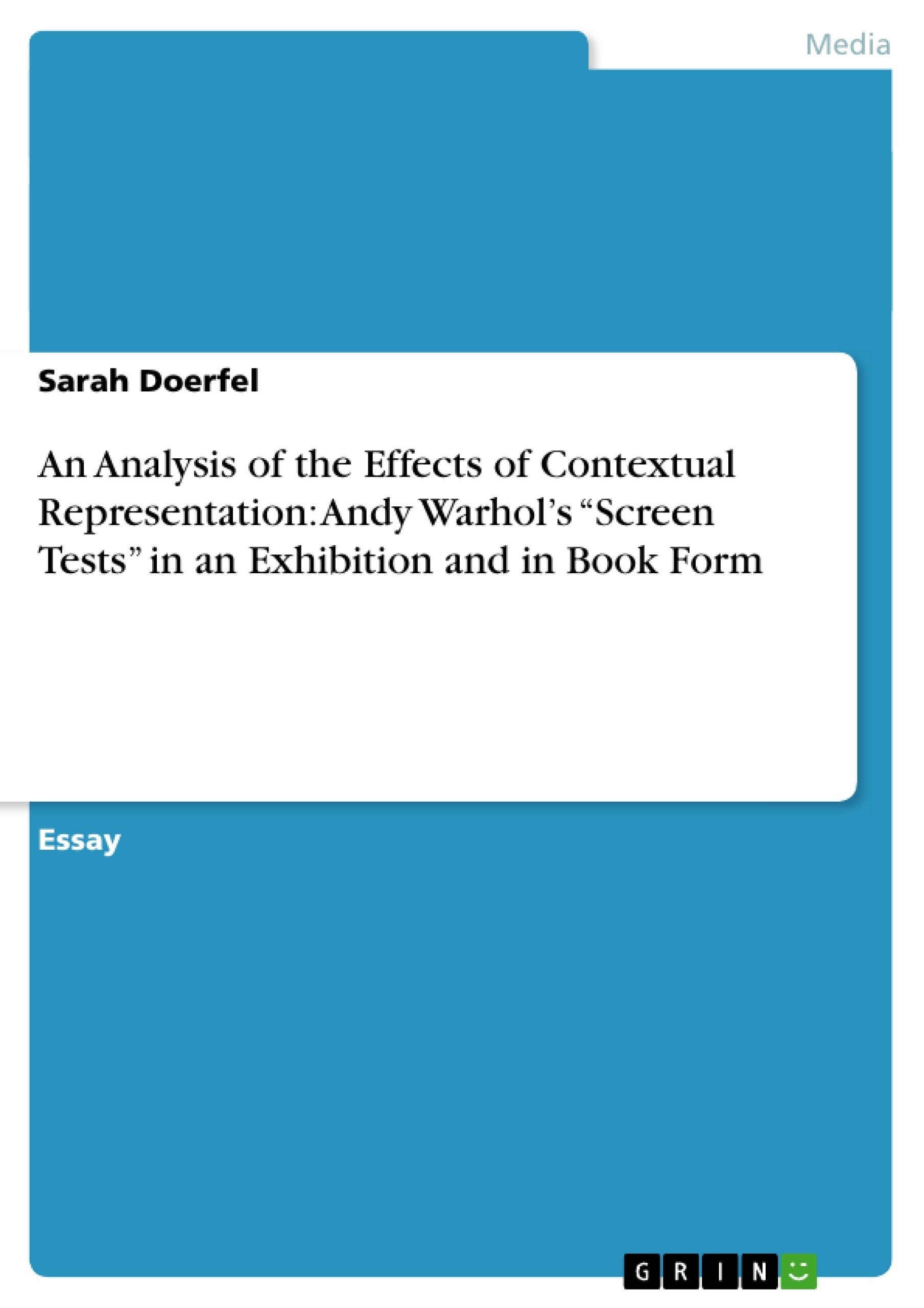In 1964 Pop artist Andy Warhol started to take his “Screen Tests”, short portrait films of his colleagues and friends who visited him in his famous studio, the “Factory” in New York.
Today, more than forty years after the last test was taken, fascination with the films still motivates people to look at them in exhibitions and books. They still catch us with their complex character as time witnesses and social documents, combined with a strong effect as extraordinarily personal pieces of art.
In the following essay, I will illustrate in which way these complex films and their meanings are shaped in different contexts of representation: installed in an exhibition and printed in book form.
At first when dealing with this question, it needs to be clear what the Screen Tests are: The films are not screen tests in the conventional sense of the word. The term usually means short test films taken of actors on castings to decide if they get a part in a film. In Warhol’s Screen Tests, the sitter was instructed to look straight into the camera, without movement or emoting, and if possible even without blinking over the three minutes of recording time. People were recorded in close- ups, deprived of the chance to hide even the smallest movement of their faces (Angell, 2006).
The “Stillies”, as Warhol called them in the beginning, were often produced spontaneously and with casual rapidity. The conceptual sophistication of these films as a whole makes this long- term project a central piece of Warhol’s work as a portrait artist in the medium of both film and painting. They can be seen as the “stem cells of Warhol’s portraiture” (Angell, 2006, p.12): Giving us an overview over the world of fame and glamour in the 1960s scene, with almost exclusively well- known sitters, they deal with the same objects – celebrities – as Warhol’s paintings do.
Like all of Warhol’s early films, they are taken on his first film camera “Bolex” in black- and- white and on silent speed (16 instead of 24 frames per second). It is especially the combination of the slow silent speed, the almost- stillness of the obedient sitters and the unusual lack of sound in the films, which makes these portraits “hybrid art images” (Sokolowski, 2004, p. 9), on the borderline between still photography and the moving image.
Inhaltsverzeichnis
- An Analysis of the Effects of Contextual Representation: Andy Warhol's "Screen Tests" in an Exhibition and in Book Form.
- The Screen Tests
- The Exhibition "Andy Warhol: Motion Pictures" at the Museum of Modem Alt
- The Catalogue Raisonné "Andy Warhol Screen Tests — The Films of Andy Warhol" by Callie Angell
- Fazit
- Literaturverzeichnis
Zielsetzung und Themenschwerpunkte
Diese Arbeit analysiert, wie die Bedeutung von Andy Warhols "Screen Tests" durch unterschiedliche Kontexte der Repräsentation beeinflusst wird. Die Untersuchung konzentriert sich auf die Präsentation der "Screen Tests" in einer Ausstellung im Museum of Modern Art in New York und in einem Buch von Callie Angell.
- Die Bedeutung der "Screen Tests" als Zeitzeugen und soziale Dokumente
- Der Einfluss des Kontextes auf die Interpretation der "Screen Tests"
- Die Rolle der "Screen Tests" als psychologisches Experiment
- Die politischen Aspekte der "Screen Tests" und Warhols Umgang mit seinen Models und Sponsoren
- Die "Screen Tests" als einzigartige Quelle für Einblicke in die New Yorker Kunstszene der 1960er Jahre
Zusammenfassung der Kapitel
- An Analysis of the Effects of Contextual Representation: Andy Warhol's "Screen Tests" in an Exhibition and in Book Form.
Die Arbeit untersucht, wie die Bedeutung von Andy Warhols "Screen Tests" durch unterschiedliche Kontexte der Repräsentation beeinflusst wird. Die Untersuchung konzentriert sich auf die Präsentation der "Screen Tests" in einer Ausstellung im Museum of Modern Art in New York und in einem Buch von Callie Angell.
- The Screen Tests
Die "Screen Tests" sind kurze Portraitfilme, die Andy Warhol von 1964 bis 1966 in seinem Studio "The Factory" drehte. Die Modelle wurden angewiesen, während der dreiminütigen Aufnahme still in die Kamera zu schauen, ohne zu blinzeln oder Emotionen zu zeigen. Die "Screen Tests" werden als "hybrid art images" bezeichnet, die zwischen Stillfotografie und bewegtem Bild stehen.
- The Exhibition "Andy Warhol: Motion Pictures" at the Museum of Modem Alt
Die Ausstellung "Andy Warhol: Motion Pictures" im Museum of Modern Art in New York zeigte eine Auswahl von Warhols Filmen, darunter auch die "Screen Tests". Die "Screen Tests" wurden in der Ausstellung in großformatigen Projektionen präsentiert, die die Betrachter in eine ähnliche Situation wie die Modelle versetzten.
- The Catalogue Raisonné "Andy Warhol Screen Tests — The Films of Andy Warhol" by Callie Angell
Callie Angell veröffentlichte 2006 ein zweibändiges Werk über Andy Warhols Filme, wobei der erste Band ausschließlich den "Screen Tests" gewidmet ist. Das Buch bietet eine umfassende Dokumentation der "Screen Tests" und beleuchtet ihre Bedeutung als Zeitzeugen der New Yorker Kunstszene der 1960er Jahre.
Schlüsselwörter
Die Schlüsselwörter und Schwerpunktthemen des Textes umfassen Andy Warhols "Screen Tests", die Repräsentation von Kunst, die Bedeutung von Kontext, die New Yorker Kunstszene der 1960er Jahre, Pop Art, die "Factory" und die Rolle der Medien in der Kunst.
- Quote paper
- Sarah Doerfel (Author), 2011, An Analysis of the Effects of Contextual Representation: Andy Warhol’s “Screen Tests” in an Exhibition and in Book Form, Munich, GRIN Verlag, https://www.grin.com/document/208188
-

-

-

-
Upload your own papers! Earn money and win an iPhone X. -

-
Upload your own papers! Earn money and win an iPhone X. -

-
Upload your own papers! Earn money and win an iPhone X. -

-
Upload your own papers! Earn money and win an iPhone X. -

-
Upload your own papers! Earn money and win an iPhone X.

